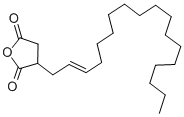2-DODECEN-1-YLSUCCINIC ANHYDRIDE
Synonym(s):3-(2-Dodecylen-1-yl)-dihydro-2,5-furandione;Dodecenylsuccinic anhydride
- CAS NO.:19780-11-1
- Empirical Formula: C16H26O3
- Molecular Weight: 266.38
- MDL number: MFCD00005528
- EINECS: 243-296-9
- SAFETY DATA SHEET (SDS)
- Update Date: 2025-07-16 09:55:24

What is 2-DODECEN-1-YLSUCCINIC ANHYDRIDE?
Chemical properties
colourless to light yellow viscous liquid
The Uses of 2-DODECEN-1-YLSUCCINIC ANHYDRIDE
(2-Dodecen-1-yl)succinic anhydride may be used in the following:
- Synthesis of amphiphilic N-[(2′-(dodec-2′-en-10-yl)succinoyl]chitosan.
- Chemical modification of sago starch, via esterification.
- Preparation of dodecenyl succinic anhydride (DDSA) gum arabic derivatives, via chemical modification of gum arabic.
General Description
Light yellow clear viscous oil.
Air & Water Reactions
May decompose in water to form organic acids
Reactivity Profile
2-DODECEN-1-YLSUCCINIC ANHYDRIDE can react with strong oxidizing agents. React with water to give the corresponding organic acid .
Fire Hazard
2-DODECEN-1-YLSUCCINIC ANHYDRIDE is non-flammable.
Flammability and Explosibility
Non flammable
Properties of 2-DODECEN-1-YLSUCCINIC ANHYDRIDE
| Melting point: | 41-43 °C(lit.) |
| Boiling point: | 180-182 °C5 mm Hg(lit.) |
| Density | 1.00 g/mL at 20 °C |
| vapor density | 9.2 (vs air) |
| vapor pressure | <1 mm Hg ( 20 °C) |
| refractive index | 1.5400 (estimate) |
| Flash point: | 352 °F |
| solubility | 5g/L in organic solvents at 20 ℃ |
| form | powder to lump |
| color | White to Orange to Green |
| Water Solubility | 130μg/L at 25℃ |
| Stability: | Stable, but moisture-sensitive. Combustible. Incompatible with water. |
| CAS DataBase Reference | 19780-11-1(CAS DataBase Reference) |
| EPA Substance Registry System | 2-Dodecenylsuccinic anhydride (19780-11-1) |
Safety information for 2-DODECEN-1-YLSUCCINIC ANHYDRIDE
| Signal word | Warning |
| Pictogram(s) |
 Exclamation Mark Irritant GHS07 |
| GHS Hazard Statements |
H315:Skin corrosion/irritation H319:Serious eye damage/eye irritation H335:Specific target organ toxicity, single exposure;Respiratory tract irritation |
| Precautionary Statement Codes |
P261:Avoid breathing dust/fume/gas/mist/vapours/spray. P264:Wash hands thoroughly after handling. P264:Wash skin thouroughly after handling. P271:Use only outdoors or in a well-ventilated area. P280:Wear protective gloves/protective clothing/eye protection/face protection. P302+P352:IF ON SKIN: wash with plenty of soap and water. P305+P351+P338:IF IN EYES: Rinse cautiously with water for several minutes. Remove contact lenses, if present and easy to do. Continuerinsing. |
Computed Descriptors for 2-DODECEN-1-YLSUCCINIC ANHYDRIDE
New Products
tert-butyl 9-methoxy-3-azaspiro[5.5]undecane-3-carboxylate Boc-Arg-OH HCl H2O Indole Methyl Resin 2-CTC Resin Gabapentin EP Impurity A 2,5-dichloro-N-hydroxy-4,6-dimethylpyridine-3-carboximidamide 4-Chloro-7-tosy1-7Hpyrrolo[2,3-d]pyrimidine 1,3-Diphenylurea 1,1’-CARBONYLDIIMIDAZOLE R-2-BENZYLOXY PROPIONIC ACID N-METHYL INDAZOLE-3-CARBOXYLIC ACID 2-Hydroxy-5-nitroacetophenone 3-(4-morpholinophenylamino)-5-amino-1H-pyrazole-4-carbonitrile Methyl 2-methylquinoline-6-carboxylate 2,4-dihydroxybenzaldehyde 1,3-Diethyl-1,3-Diphenylurea 2-((4-morpholinophenylamino) (methylthio) methylene) malononitrile 2-HYDROXY BENZYL CYANIDE DIETHYL AMINOMALONATE HYDROCHLORIDE 5-BROMO-2CYANO PYRIDINE Boldenone Clarithromycin Ethinyl Estradiol StanozololRelated products of tetrahydrofuran








You may like
-
 2-Dodecen-1-ylsuccinic Anhydride (cis- and trans- mixture) CAS 19780-11-1View Details
2-Dodecen-1-ylsuccinic Anhydride (cis- and trans- mixture) CAS 19780-11-1View Details
19780-11-1 -
 (2-Dodecen-1-yl)succinic anhydride CAS 19780-11-1View Details
(2-Dodecen-1-yl)succinic anhydride CAS 19780-11-1View Details
19780-11-1 -
 CIS BROMO BENZOATE 98%View Details
CIS BROMO BENZOATE 98%View Details
61397-56-6 -
 90-01-7 2-HYDROXY BENZYL ALCOHOL 98%View Details
90-01-7 2-HYDROXY BENZYL ALCOHOL 98%View Details
90-01-7 -
 3-NITRO 2-METHYL BENZOIC ACID 98%View Details
3-NITRO 2-METHYL BENZOIC ACID 98%View Details
1975-50-4 -
 221615-75-4 2-Chloro-1,3-Bis(Dimethylamino)Trimethinium Hexafluorophosphate 98%View Details
221615-75-4 2-Chloro-1,3-Bis(Dimethylamino)Trimethinium Hexafluorophosphate 98%View Details
221615-75-4 -
 2033-24-1 MELDRUMS ACID 98%View Details
2033-24-1 MELDRUMS ACID 98%View Details
2033-24-1 -
 42831-50-5 98%View Details
42831-50-5 98%View Details
42831-50-5
Statement: All products displayed on this website are only used for non medical purposes such as industrial applications or scientific research, and cannot be used for clinical diagnosis or treatment of humans or animals. They are not medicinal or edible.
